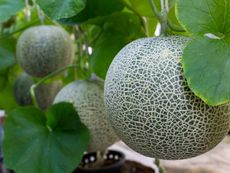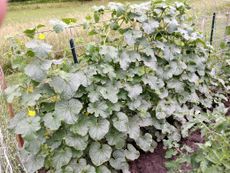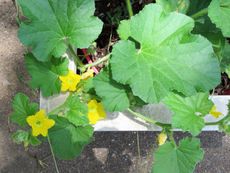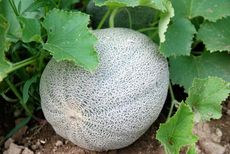Planting Cantaloupe - How To Grow Cantaloupe Melons


The cantaloupe plant, also known as muskmelon, is a popular melon that is commonly grown in many home gardens, as well as commercially. It is easily recognized by the net-like rind and sweet orange color inside. Cantaloupes are closely related to cucumbers, squash, and pumpkins, therefore, share similar growing conditions.
How to Grow Cantaloupe
Anyone growing cucurbits (squash, cucumber, pumpkin, etc.) can grow cantaloupes. When planting cantaloupe, wait until the threat of frost has passed and the soil has warmed in spring. You can either sow seeds directly in the garden or in flats inside (do this well before their initial planting outdoors), or you can use transplants purchased from reputable nurseries or garden centers. These plants need plenty of sun with warm, well-draining soil—preferably with pH levels between 6.0 and 6.5. Seeds are usually planted anywhere from ½ to 1 inch (1-2.5 cm.) deep, and in groups of three. Although not required, I like to plant them in small hills or mounds as I do with other cucurbit members. Cantaloupe plants are generally spaced about 2 feet (61 cm.) apart with rows 5 to 6 feet (1.5-2 m.) apart. Transplants can be set out once the temperatures have warmed and they've developed their second or third set of leaves. Purchased plants are normally ready for planting right away. These, too, should be spaced about 2 feet (61 cm.) apart. Note: You can also plant cantaloupes along a fence or allow the plants to climb a trellis or small stepladder. Just make sure to add something that will cradle the fruits as they grow—such as a sling made from pantyhose—or set the fruits on the steps of your ladder.
Caring for and Harvesting Cantaloupe Plant
Following the planting of cantaloupe plants, you'll need to water them thoroughly. They'll also require weekly watering of around 1 to 2 inches (2.5-5 cm.) worth, preferably through drip irrigation. Mulch is another factor to consider when growing cantaloupe. Mulch not only keeps the soil warm, which these plants enjoy, but it helps retain moisture, minimizes weed growth, and keeps fruit off the soil (of course, you can set them on small pieces of board too). While many people prefer to use plastic mulch when they grow cantaloupes, you can use straw as well. Within about a month or so after the fruit has set, cantaloupes should be ready for harvesting. A ripe cantaloupe will separate from the stem with ease. Therefore, if you're unsure about when to harvest, you can simply check the stem where your melon is attached and see if the cantaloupe comes off. If it doesn't, leave it a little longer but check often.
Gardening tips, videos, info and more delivered right to your inbox!
Sign up for the Gardening Know How newsletter today and receive a free download of our most popular eBook "How to Grow Delicious Tomatoes."

Nikki Tilley has been gardening for nearly three decades. The former Senior Editor and Archivist of Gardening Know How, Nikki has also authored six gardening books.
-
 How To Get Rid Of Mosquitoes In The Garden: 9 Natural Ways To Make Them Buzz Off!
How To Get Rid Of Mosquitoes In The Garden: 9 Natural Ways To Make Them Buzz Off!How to get rid of mosquitoes is on the minds of people in the summer in almost every region of the world. Learn how to repel the pests without toxic chemicals.
By Mary Ellen Ellis
-
 Monkey Orchid Care: How To Grow This Fascinating Species
Monkey Orchid Care: How To Grow This Fascinating SpeciesThe monkey orchid bears a remarkable resemblance to its namesake and, with a little know-how, can be successfully grown as a houseplant.
By Bonnie L. Grant
-
 How To Prune Cantaloupe Vines: Is Cutting Back Cantaloupes Effective
How To Prune Cantaloupe Vines: Is Cutting Back Cantaloupes EffectiveCutting back cantaloupe plants is generally not necessary, although pruning cantaloupe plants does have some benefits. Click here to learn more.
By Amy Grant
-
 Athena Melon Fruit: What Is An Athena Melon Plant
Athena Melon Fruit: What Is An Athena Melon PlantAthena melon fruit are cantaloupe hybrids prized for their consistent early yields as well as for their ability to store and ship well. Interested in growing Athena melons? Click the following article to learn about the growing and care of Athena melons.
By Amy Grant
-
 Cantaloupe On A Trellis: How To Grow Cantaloupes Vertically
Cantaloupe On A Trellis: How To Grow Cantaloupes VerticallyTrellised cantaloupes utilize a much smaller portion of the garden, allowing even those with limited space to grow their own. Intrigued? Click on the following article to find out how to grow cantaloupes vertically and other information.
By Amy Grant
-
 Container Grown Cantaloupe: Care Of Cantaloupe In Pots
Container Grown Cantaloupe: Care Of Cantaloupe In PotsCan I grow cantaloupes in a container garden? This is a common question, and space-challenged melon lovers are happy to learn that the answer is a resounding yes, you can grow cantaloupe in pots with proper growing conditions. Click here for more info.
By Mary H. Dyer
-
 The Right Time To Pick A Cantaloupe - How And When To Pick Cantaloupe
The Right Time To Pick A Cantaloupe - How And When To Pick CantaloupeKnowing the right time to pick a cantaloupe can mean the difference between a good crop and a bad one. Follow the tips in this article to harvest the best cantaloupe fruits possible.
By Nikki Tilley